Cross-Laminated Timber (CLT) in Compression Perpendicular to the Plane: Experimental Analysis on the Column below the Wall Load Configuration
Abstract
:1. Introduction
2. Experimental Program
2.1. Raw Material
2.2. Clear Wood Properties
2.3. CLT Manufacturing and Specimens
2.4. Compression Stress Dispersion Models
2.5. Compression Perpendicular to the Plane Test
3. Results and Discussion
3.1. Experimental Results
3.1.1. Cubic Specimens
3.1.2. Plate Specimens
3.1.3. Compressive Stress Dispersion and kc,90 Factor
3.1.4. Comparison of Compression Perpendicular to the Grain Properties
- The elastic modulus in compression perpendicular to the grain decreases due to the size effect.
- The elastic modulus in compression perpendicular to the grain increases due to the increase in thickness.
4. Conclusions
- When comparing the compression perpendicular to the grain properties of clear specimens and cubic samples under uniform compression, there was an approximate reduction of 30% in the modulus perpendicular to the grain. This can be attributed to distinct failure modes and their associated mechanisms observed in CLT panels. The reduction in strength perpendicular to the grain was, however, found to be less affected.
- For a constant overall depth (105 mm) of CLT with varying numbers of layers (three vs. five layers), the modulus of elasticity perpendicular to the grain was found to be 21% higher for CLT with more layers. This effect on the compressive strength perpendicular to the grain was less significant.
- With an increase in the overall depth of CLT (105 vs. 175 mm), the modulus of elasticity perpendicular to the grain was found to be reduced by 17%. The increased depth can lead to an increased likelihood of internal stresses and deformations within the panel due to variations in moisture content and drying gradients. These internal stresses can affect the overall stiffness and contribute to a reduction in the modulus of elasticity perpendicular to the grain.
- For the CLT plate tests, the overall depth of the CLT significantly influences both the modulus of elasticity and strength under compression perpendicular to the grain. An increase of 47 to 68% in modulus of elasticity and an increase of 30 to 38% in strength were observed as the overall depth increased from 105 to 175 mm.
- While determining the kc,90 factor analytically, both Van Der Put’s exact dispersion model and Brander’s simplified model yield similar results, irrespective of the depth of the CLT panel. However, there might be an accuracy limitation for these approaches with increasing CLT thickness due to the larger variation of stress distribution with the larger wood volume being loaded.
Author Contributions
Funding
Data Availability Statement
Acknowledgments
Conflicts of Interest
References
- Ascione, F.; Esposito, F.; Iovane, G.; Faiella, D.; Faggiano, B.; Mele, E. Sustainable and Efficient Structural Systems for Tall Buildings: Exploring Timber and Steel–Timber Hybrids through a Case Study. Buildings 2024, 14, 524. [Google Scholar] [CrossRef]
- Aleksandr, C.; Tatiana, B.; Viktor, T.; Anton, K. On the possibility of using timber structures in the construction of high-rise buildings in seismic areas. Archit. Eng. 2023, 8, 60–70. [Google Scholar]
- Ilgın, H.E. Tallest Timber Buildings: Main Architectural and Structural Design Considerations; IntechOpen: London, UK, 2016; Volume i, p. 13. [Google Scholar]
- Salvadori, V. Multi-Storey Timber-Based Buildings: An International Survey of Case-Studies with Five or More Storeys over the Last Twenty Years; Technische Universität Wien: Vienna, Austria, 2021; pp. 1–527. [Google Scholar]
- Brandner, R. Cross Laminated Timber (CLT) in Compression Perpendicular to Plane: Testing, Properties, Design and Recommendations for Harmonizing Design Provisions for Structural Timber Products. Eng. Struct. 2018, 171, 944–960. [Google Scholar] [CrossRef]
- EN 1995-1:2004; Eurocode 5: General—Common Rules and Rules for Buildings. CEN: Brussels, Belgium, 2004; Volume 1.
- Halili, Y. Versuchstechnische Ermittlung von Querdruckkenngrössen für Brettsperrholz (BSP). Master’s Thesis, Technische Universität Graz, Styria, Austria, 2008. [Google Scholar]
- Serrano, E.; Enquist, B. Compression Strength Perpendicular to Grain in Cross-Laminated Timber (CLT). In Proceedings of the 11th World Conference on Timber Engineering 2010, WCTE 2010, Trentino, Italy, 20–24 June 2010; Volume 1, pp. 441–448. [Google Scholar]
- Salzmann, C. Ermittlung von Querdruckkenngrößen Für Brettsperrholz (BSP). Master’s Thesis, Technische Universität Graz, Styria, Austria, 2010. Available online: https://diglib.tugraz.at/download.php?id=576a73e2a4585&location=browse (accessed on 22 February 2024).
- Bogensperger, T.; Augustin, M.; Schickhofer, G. Properties of CLT-Panels Exposed to Compression Perpendicular to Their Plane. In Proceedings of the 44th International Council for Research and Innovation in Building and Construction, Working Commission W18—Timber Structures, Alghero, Italy, 28 August–1 September 2011; pp. 1–15. [Google Scholar]
- Ciampitti, A. Untersuchung Ausgewählter Einflussparameter Auf Die Querdruckkenngrößen von Brettsperrholz. Master’s Thesis, Technische Universität Graz, Styria, Austria, 2013. Available online: https://diglib.tugraz.at/download.php?id=576a76a59e99b&location=browse (accessed on 22 February 2024).
- Jowat Liquid One-Component Polyurethane Adhesive for Load-Bearing Structural Wood Bonding. Available online: https://www.jowat.com/technical-data-sheets/686.30/TD68630_Englisch.PDF (accessed on 10 February 2020).
- EN 408:2004; Structural Timber and Glued Laminated Timber. Determination of Some Physical and Mechanical Properties. CEN: Brussels, Belgium, 2004; Volume 35. [CrossRef]
- ISO 13910:2014; Timber Structures—Strength Graded Timber—Test Methods for Structural Properties. ISO: Geneva, Switzerland, 2014.
- Franke, S.; Quenneville, P. Compression Behavior and Material Parameters of Radiata Pine at Different Orientations to the Grain. J. Mater. Civ. Eng. 2013, 25, 1514–1523. [Google Scholar] [CrossRef]
- Mendes, R.A.B. Structural Behaviour of Cross-Laminated Timber Panels Subjected to Out-of-Plane Loading: An Experimental and Numerical Approach; Universidade Federal do Rio Grande do Sul, Rio Grande, Brazil, 2020. Available online: https://lume.ufrgs.br/bitstream/handle/10183/221467/001125947.pdf?sequence=1&isAllowed=y (accessed on 22 February 2024).
- Bao, F.C.; Jiang, Z.H.; Jiang, X.M.; Lu, X.X.; Luo, X.Q.; Zhang, S.Y. Differences in Wood Properties between Juvenile Wood and Mature Wood in 10 Species Grown in China. Wood Sci. Technol. 2001, 35, 363–375. [Google Scholar] [CrossRef]
- Kretschmann. Wood as an Engineering Material. 2010. Available online: https://www.fpl.fs.usda.gov/documnts/fplgtr/fpl_gtr190.pdf (accessed on 22 February 2024).
- NBR 7190 Projeto de Estruturas de Madeira. 1997. Available online: https://aetec.org.br/nbr-7190-projeto-de-estruturas-de-madeira/ (accessed on 22 February 2024).
- Pearson, K. Tables for Statisticians and Biometricians. Nature 1932, 130, 931. [Google Scholar] [CrossRef]
- EN 16351; Timber Structures—Cross Laminated Timber. CEN: Brussels, Belgium, 2021.
- EN 1995-2; Eurocode 5: Design of Timber Structures—Part 2: Bridges. CEN: Brussels, Belgium, 2004; Volume 1, p. 123.
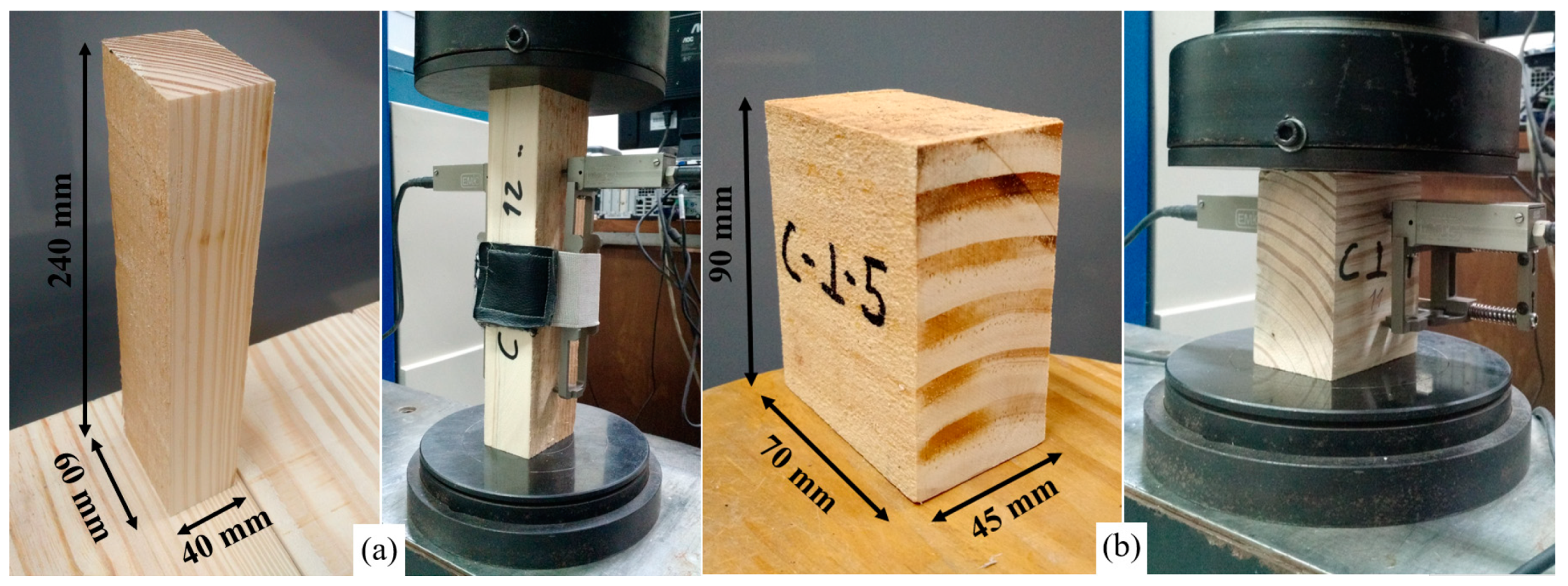
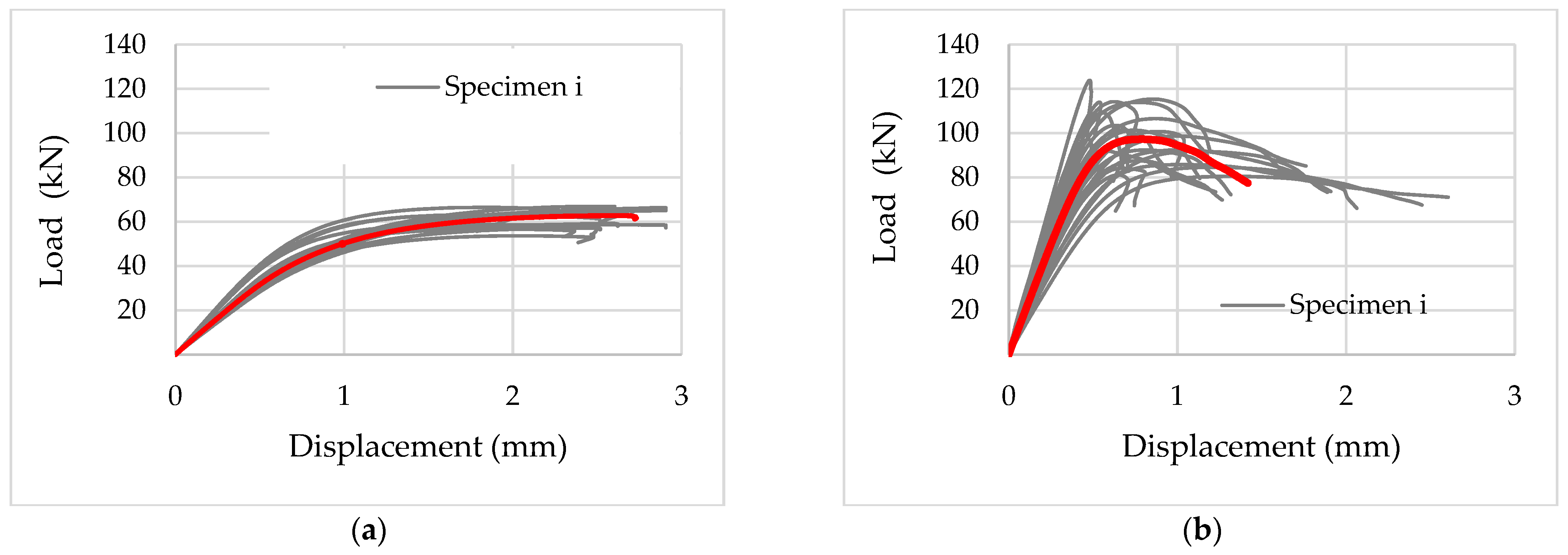
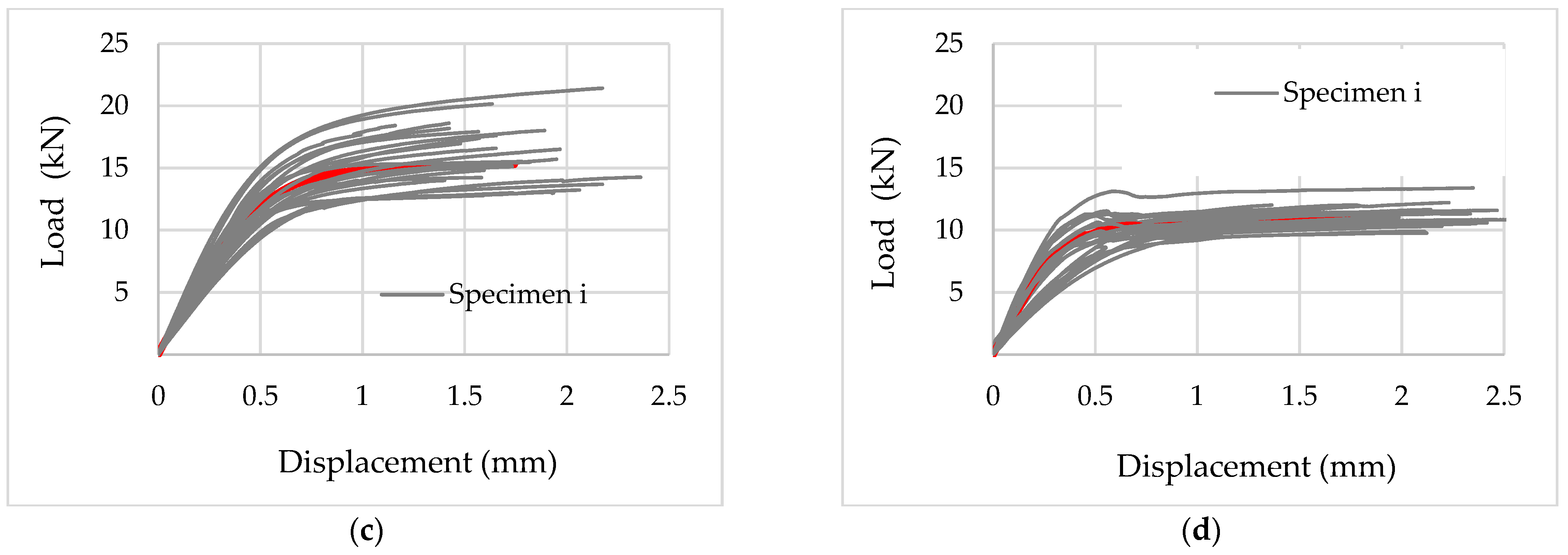


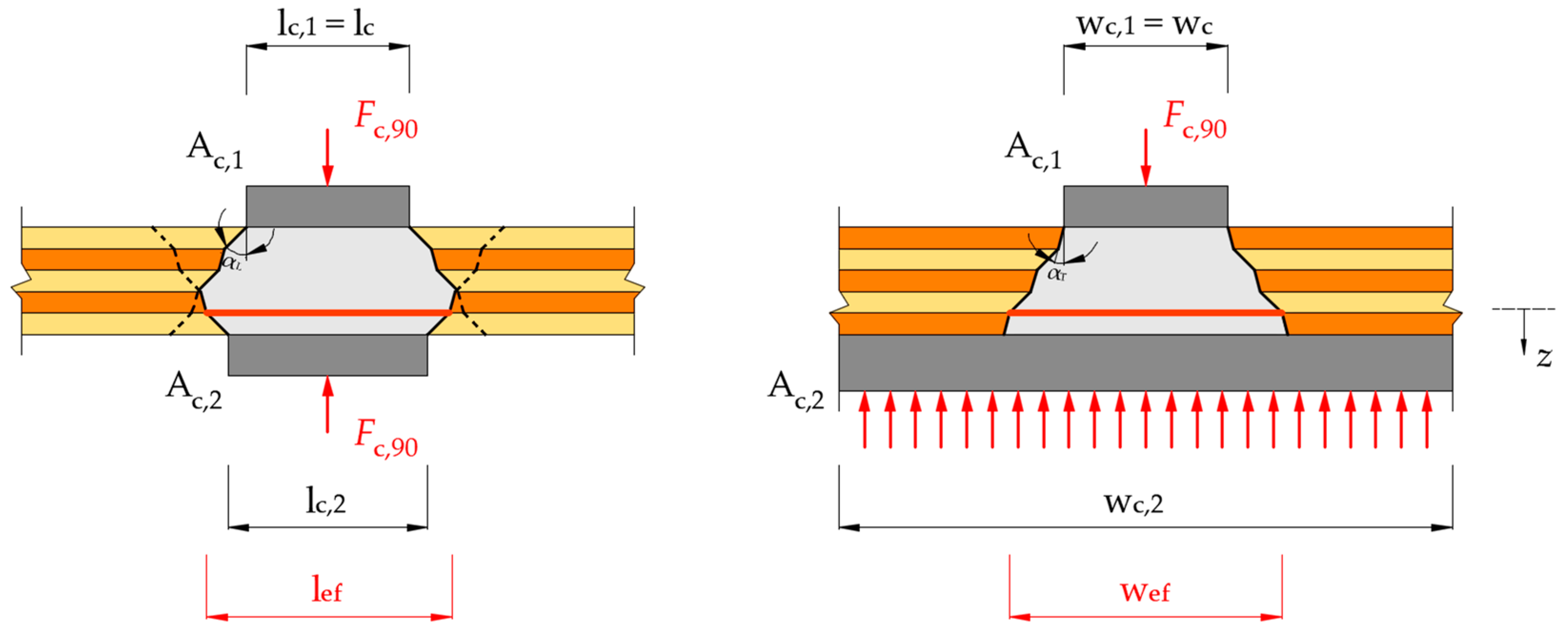


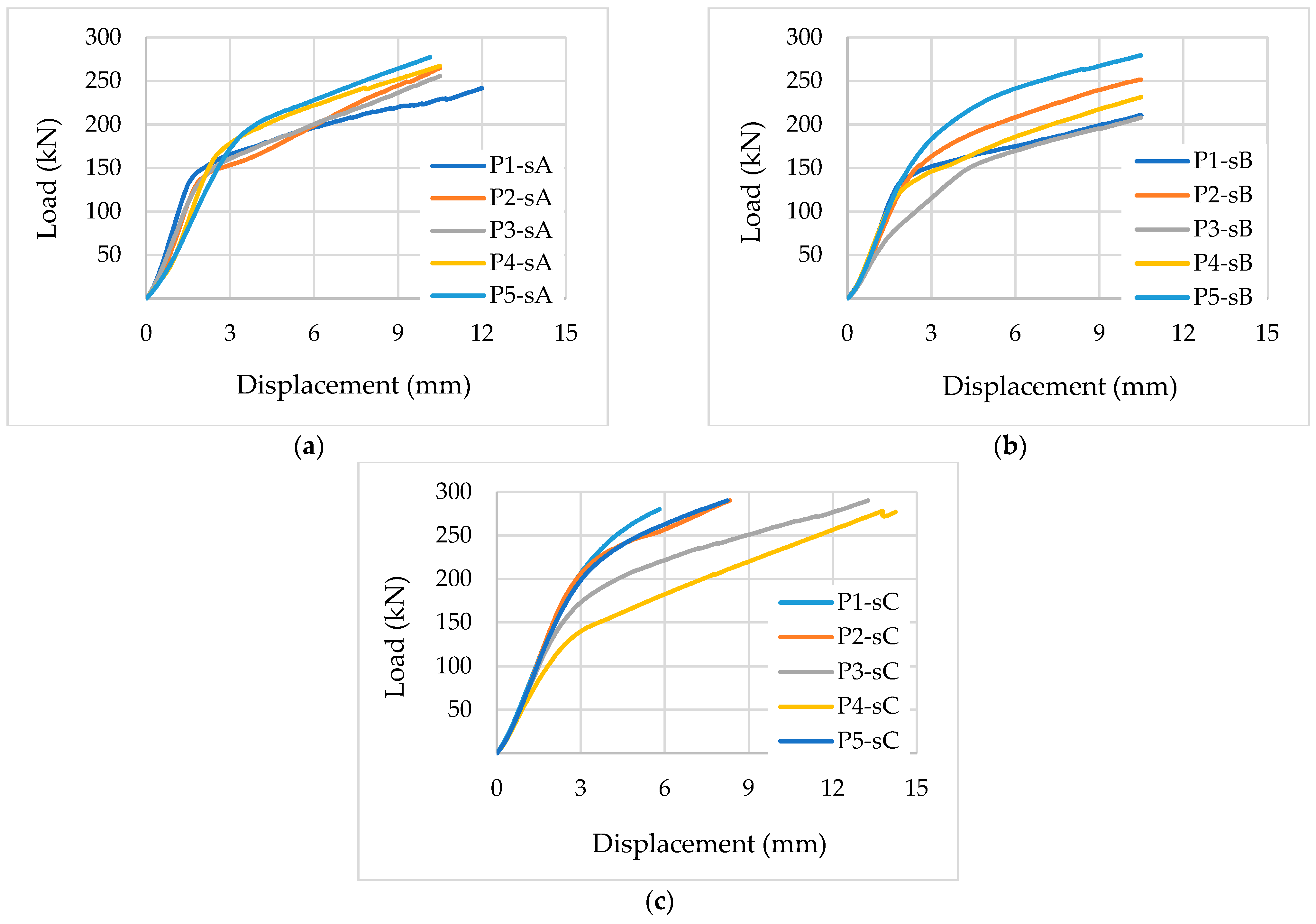

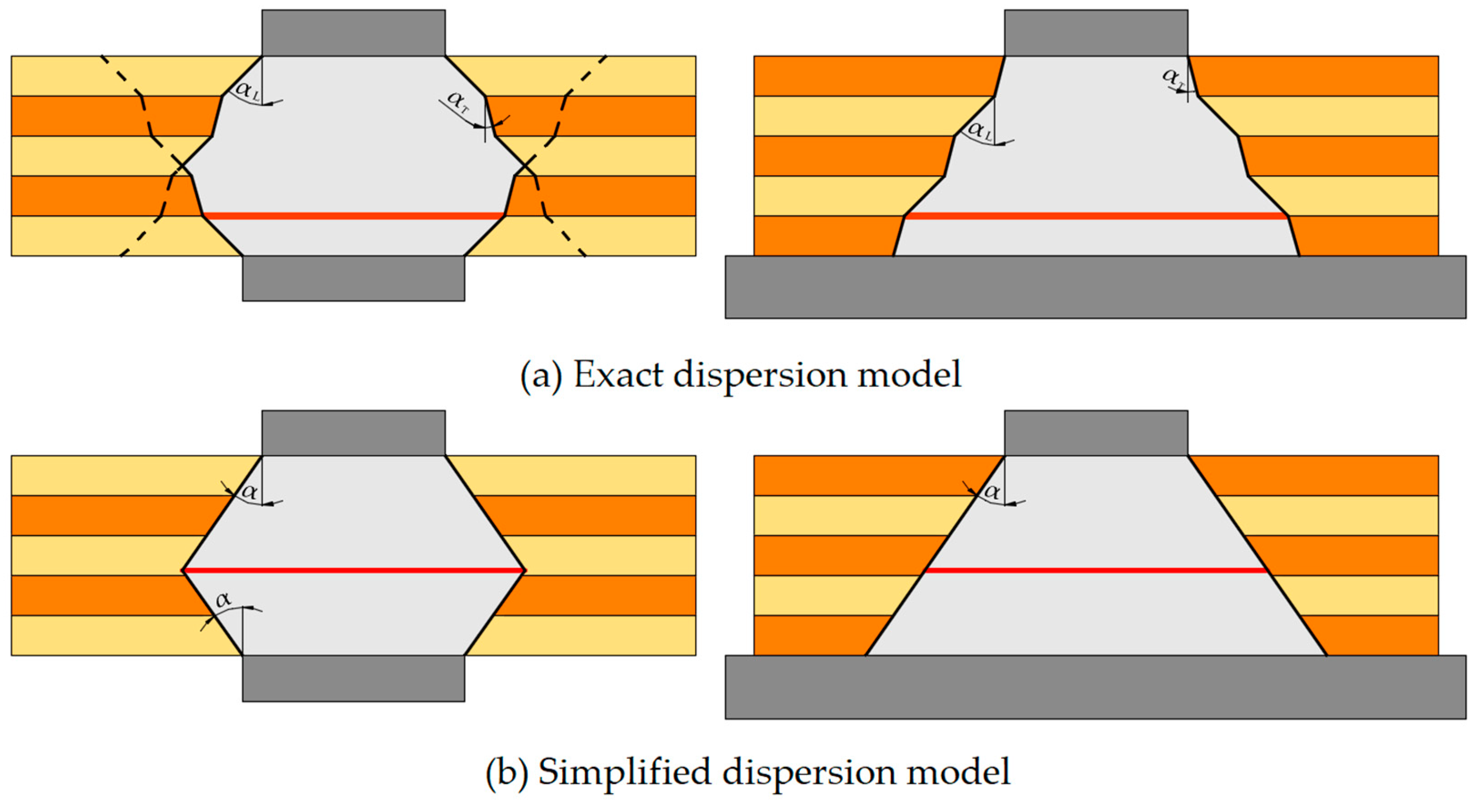
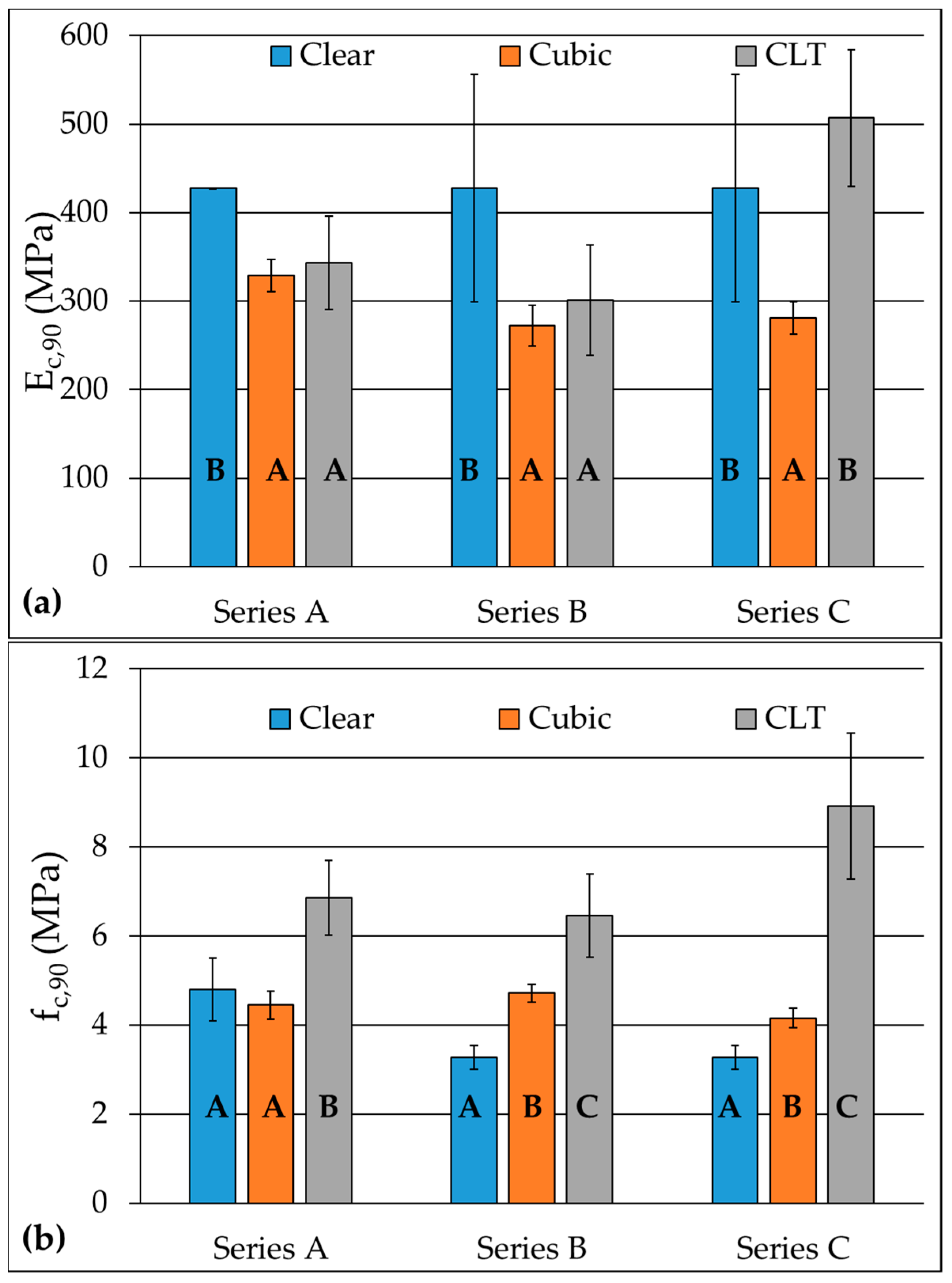
| Batch | Statistics | ρ (kg/m3) | Ec,0 (MPa) | fc,0 (MPa) | Ec,90 (MPa) | fc,90 (MPa) | fc,y (MPa) | T (MPa) |
|---|---|---|---|---|---|---|---|---|
| 1 | max. | 511 | 5358 | 27.36 | 580 | 6.24 | 5.80 | 38.06 |
| Average | 495 | 4268 | 25.46 | 427 | 4.80 | 4.52 | 18.94 | |
| min. | 482 | 3577 | 22.10 | 328 | 3.93 | 3.71 | 5.39 | |
| SD | 9.94 | 575.8 | 1.63 | 66.54 | 0.70 | 0.62 | 9.73 | |
| CV (%) | 2.01 | 13.49 | 6.40 | 15.57 | 14.60 | 13.73 | 41.04 | |
| G1 | - | 0.808 | −0.561 | 0.348 | 0.510 | - | 0.149 | |
| 2 | max. | 501 | 20,020 | 49.52 | 654 | 3.92 | 4.05 | 22.58 |
| Average | 467 | 13,070 | 40.44 | 428 | 3.27 | 3.14 | 9.49 | |
| min. | 452 | 8005 | 32.11 | 242 | 2.83 | 2.68 | 2.47 | |
| SD | 13.75 | 2771 | 5.06 | 128.84 | 0.26 | 0.32 | 6.46 | |
| CV (%) | 2.95 | 21.21 | 12.52 | 30.12 | 7.99 | 10.23 | 68.02 | |
| G1 | - | 0.470 | 0.027 | 0.025 | 0.570 | - | 0.859 |
| Series | Type of Test | No. of Layers | Thickness of Each Layer (mm) | Total Thickness of CLT (mm) | Width (mm) × Length (mm) of CLT Specimens | No. of Samples |
|---|---|---|---|---|---|---|
| Series A | CLT plate compressed under the wall below the column load configuration | 5 | 21 | 105 | 600 × 600 | 5 |
| Series B | 3 | 35 | 105 | 600 × 600 | 5 | |
| Series C | 5 | 35 | 175 | 600 × 600 | 5 | |
| Series A | CLT prism under pure compression perpendicular to the plane | 5 | 21 | 105 | 160 × 160 | 6 |
| Series B | 3 | 35 | 105 | 160 × 160 | 6 | |
| Series C | 5 | 35 | 175 | 160 × 160 | 6 |
| Series | Ec,90,CLT,p (MPa) | SD (MPa) | CV (%) | |||
|---|---|---|---|---|---|---|
| min. | Average | Median | max. | |||
| A | 308.3 | 328.9 | 329.0 | 357.0 | 18.08 | 5.50 |
| B | 239.6 | 272.2 | 274.0 | 302.7 | 22.87 | 8.41 |
| C | 259.2 | 281.1 | 277.5 | 308.7 | 18.40 | 6.55 |
| Series | fc,90,CLT,p (MPa) | SD (MPa) | CV (%) | |||
| min. | Average | Median | max. | |||
| A | 4.08 | 4.45 | 4.39 | 4.94 | 0.31 | 6.93 |
| B | 4.51 | 4.72 | 4.68 | 5.10 | 0.20 | 4.25 |
| C | 3.95 | 4.16 | 4.10 | 4.49 | 0.22 | 5.34 |
| Series | Ec,90,CLT,Lc (MPa) | SD (MPa) | CV (%) | |||
|---|---|---|---|---|---|---|
| min. | Average | Median | max. | |||
| A | 265.0 | 343.2 | 352.0 | 411.0 | 53.31 | 15.90 |
| B | 192.0 | 301.0 | 331.0 | 340.0 | 62.13 | 20.64 |
| C | 375.0 | 507.0 | 542.0 | 569.0 | 77.12 | 15.21 |
| Series | fc,90,CLT,Lc (MPa) | SD (MPa) | CV (%) | |||
| min. | Average | Median | max. | |||
| A | 6.02 | 6.87 | 6.40 | 7.91 | 0.83 | 12.16 |
| B | 5.72 | 6.46 | 5.96 | 7.94 | 0.94 | 14.59 |
| C | 6.32 | 8.92 | 9.28 | 10.63 | 1.65 | 18.44 |
| Series | Ac (mm2) | Ac,ef (mm2) | kc,90,VP | kc,90,s | kc,90 | |
|---|---|---|---|---|---|---|
| Ac,ef,VP | Ac,ef,s | |||||
| A | 25.600 | 63.162 | 63.001 | 1.57 | 1.57 | 1.54 |
| B | 25.600 | 58.569 | 63.001 | 1.51 | 1.57 | 1.37 |
| C | 25.600 | 89.441 | 90.000 | 1.87 | 1.88 | 2.15 |
Disclaimer/Publisher’s Note: The statements, opinions and data contained in all publications are solely those of the individual author(s) and contributor(s) and not of MDPI and/or the editor(s). MDPI and/or the editor(s) disclaim responsibility for any injury to people or property resulting from any ideas, methods, instructions or products referred to in the content. |
© 2024 by the authors. Licensee MDPI, Basel, Switzerland. This article is an open access article distributed under the terms and conditions of the Creative Commons Attribution (CC BY) license (https://creativecommons.org/licenses/by/4.0/).
Share and Cite
Mendes, R.A.B.; Benincá, M.E.; Subhani, M.; Acosta, A.P.; de Avila Delucis, R.; Désir, J.M.; Morsch, I.B.; Ilgın, H.E.; Karjalainen, M. Cross-Laminated Timber (CLT) in Compression Perpendicular to the Plane: Experimental Analysis on the Column below the Wall Load Configuration. Buildings 2024, 14, 607. https://doi.org/10.3390/buildings14030607
Mendes RAB, Benincá ME, Subhani M, Acosta AP, de Avila Delucis R, Désir JM, Morsch IB, Ilgın HE, Karjalainen M. Cross-Laminated Timber (CLT) in Compression Perpendicular to the Plane: Experimental Analysis on the Column below the Wall Load Configuration. Buildings. 2024; 14(3):607. https://doi.org/10.3390/buildings14030607
Chicago/Turabian StyleMendes, Rodrigo Adolfo Benitez, Matheus Erpen Benincá, Mahbube Subhani, Andrey Pereira Acosta, Rafael de Avila Delucis, Jean Marie Désir, Inácio Benvegnu Morsch, Hüseyin Emre Ilgın, and Markku Karjalainen. 2024. "Cross-Laminated Timber (CLT) in Compression Perpendicular to the Plane: Experimental Analysis on the Column below the Wall Load Configuration" Buildings 14, no. 3: 607. https://doi.org/10.3390/buildings14030607








